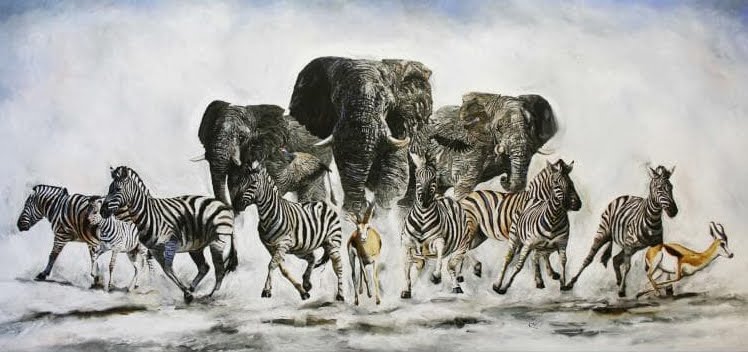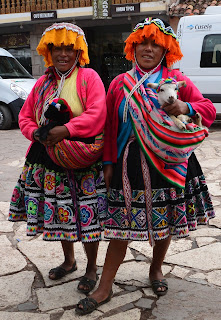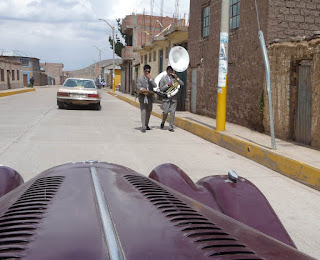Day 27 Friday 9th December 2016
Paracas to Lima 260 kms
The final day of the rally and everyone was looking forward to getting to the finish line after 27 days of driving. Not everyone finished as at least 12 cars had various problems which prevented them from continuing. A high attrition rate.
You have to be ready for the unexpected on these roads. Cars suddenly dart out from side streets, red lights and stop signs are ignored and drivers push in without looking. The sides of the roads are even used for passing, particularly by the 3 wheel taxis who push in from the right side. At least one rally car collided with one of these strange vehicles. We are surprised by the large number of Volkswagon Beetles still on the roads here and all over Peru. Other strange vehicles on the road were "tall" tractors. These look as if they are on stilts and apparently go over the top of crops. Very weird looking at them from the low slung Morgan!
After 70 kms or so we reached the coast again with high sand dunes and struggling palm trees. Along this stretch also were hundreds of condominiums on the beaches for rent or sale. There were several small islands off the coast and even these looked bleak.
Only two tests today. Two laps around the Autodromo La Chutana circuit and then one lap around the Kartodromo. We were happy with our time of 1.45min and 1.28 mins respectively.
It was then 50 kms to the finish line in front of the Country Club hotel. Each finisher had their moment of glory under the finishing arch and presented with a finishers' engraved stein (full of beer).
In the evening the Presentation Dinner was held and some great photographs of competitors were shown throughout the evening.
Tomorrow we are moving to an hotel in Miraflores and on Sunday the Australian contingent of 12 people are having a farewell lunch.
We were placed 12th overall which we were happy with given the state of the rocky gravel roads on which the Regularities took place. During the last week of competition we took it easy due to the somewhat repaired springs and broken speedo cable which meant that we had no accurate distance measurements.
Now to get the car back to Australia (being taken to the docks tomorrow morning) and repaired before its next journey, to Japan in March for the Samurai Challenge.
Forgot to mention that the Puce Goose has now been to 32 countries.
Paracas to Lima 260 kms
The final day of the rally and everyone was looking forward to getting to the finish line after 27 days of driving. Not everyone finished as at least 12 cars had various problems which prevented them from continuing. A high attrition rate.
You have to be ready for the unexpected on these roads. Cars suddenly dart out from side streets, red lights and stop signs are ignored and drivers push in without looking. The sides of the roads are even used for passing, particularly by the 3 wheel taxis who push in from the right side. At least one rally car collided with one of these strange vehicles. We are surprised by the large number of Volkswagon Beetles still on the roads here and all over Peru. Other strange vehicles on the road were "tall" tractors. These look as if they are on stilts and apparently go over the top of crops. Very weird looking at them from the low slung Morgan!
After 70 kms or so we reached the coast again with high sand dunes and struggling palm trees. Along this stretch also were hundreds of condominiums on the beaches for rent or sale. There were several small islands off the coast and even these looked bleak.
Only two tests today. Two laps around the Autodromo La Chutana circuit and then one lap around the Kartodromo. We were happy with our time of 1.45min and 1.28 mins respectively.
It was then 50 kms to the finish line in front of the Country Club hotel. Each finisher had their moment of glory under the finishing arch and presented with a finishers' engraved stein (full of beer).
In the evening the Presentation Dinner was held and some great photographs of competitors were shown throughout the evening.
Tomorrow we are moving to an hotel in Miraflores and on Sunday the Australian contingent of 12 people are having a farewell lunch.
We were placed 12th overall which we were happy with given the state of the rocky gravel roads on which the Regularities took place. During the last week of competition we took it easy due to the somewhat repaired springs and broken speedo cable which meant that we had no accurate distance measurements.
Now to get the car back to Australia (being taken to the docks tomorrow morning) and repaired before its next journey, to Japan in March for the Samurai Challenge.
Forgot to mention that the Puce Goose has now been to 32 countries.

















































